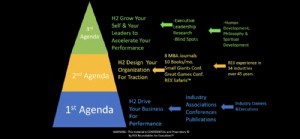Change is hard, usually harder than you ever expected. It’s a big organization’s and personal challenge. Our work with individuals trying to change as well as organizations leads us to look at change by thinking about three fairly distinct, but interrelated agendas.
Like the triage, that in the emergency medical guideline helps emergency medical personnel to prioritize the order in which they treat injuries, the three agendas helps the entrepreneurs and CEOs to understand where to focus now, what to do next and where to focus long term in addressing an organization’s challenges.
FIRST AGENDA: OPERATIONS AND TACTICS
The First agenda includes all the obvious operational issues in an organization. Managers in all industries focus on these areas. The First Agenda is where an organization is most likely to experience pain and identify problems:
-We have a cash flow problem.
-Sales is not producing results.
-Retention is declining.
-The facility is not clean.
-Staff are not doing what they are told to do
-I have too much to do.
The First Agenda items are: operations, sales, marketing, service, production, delivery, revenue, profits, value creation and customer loyalty. These describe obviously important tasks in any organization. Surveys conducted by me at several industry association conventions found that 97 percent or more of the topics focus on this first agenda.
Problems in achieving the first agenda are the typical motivators of organizational change. Likewise when we design changes they are generally described in first agenda language, such as 'sales are down so we have a new effort to boost activity in the next quarter.'
You will know if that is a deep enough analysis, by whether or not sales increase in the next quarter without producing undesired side effects. Often our efforts to change do not produce the desired change, even when we work very hard and are very persistent. This situation signals that it is time to drop down into the second agenda and look for help there.
SECOND AGENDA: CULTURE AND STRATEGY
While the first agenda focuses on the work, the Second agenda focuses on theorganization, and the mechanisms that bring people together with resources to accomplish the organization's purpose. This agenda includes vision, mission, plans, strategies, structure, research and development, delegation, staffing, systems for communication, coordination and control, resource allocation methods, rewards and recognition systems both formal and informal and finally the all-pervasive culture of the organization.
In the small organization the second agenda is less critical than in a medium or large organization, because the intimate contact and daily interaction of all the employees that is possible in the small enterprise more easily enables people to override weaknesses and design flaws in the second agenda. The second agenda addresses all group process issues e.g. how is the organization organized, what are the processes of the team, how do we structure the interaction between individuals, and most importantly, what structures and systems are in place to nurture and support change.
Each of the elements in the second agenda acts like an autopilot, which keeps the organization on its old track even when goals and actions are taken in the first agenda. In fact, increased effort on the first agenda to produce change often produces a back lash that hardens the resistance to change.
This is the same paradox many professionals experience when they say “I went into this field because I loved science” (or art or medicine or engineering or writing) not because I loved management.” Now I have advanced in my field and have to manage people.
Ignoring the second agenda in your career or in your organization allows second agenda problems to grow until they impact the first agenda, e.g. revenues in an organization or your health/marriage in your personal life.
Most organizations are currently out of balance, over emphasizing the first agenda and neglecting the second agenda. With limited resources to invest, a redistribution of resources to give more emphasis to the second agenda will produce greater progress and results in the first agenda than putting the full investment there.
THIRD AGENDA: REINNOVATION OF YOURSELF
The Third agenda addresses individual development and transformation. Individual development does not mean learning more about the first or second agenda topics. It means learning more about you and your relationship/impact on those you work with. It’s about the development of the leader(s). Successful leaders have strong egos reflected in their confidence, their intellect, their resilience and frequently in their persuasive skills. All of these make tremendous contributions to their business success. They also can create resistance to them more deeply understanding themselves and their blind spots.
Every human lives in a box whose walls are your assumptions about people, work and yourself. These assumptions stunt your growth, and you cannot see the boundaries your mind has created. The box which you have created eventually limits your ability to improve your business in the first and second agenda.
Quite naturally this learning often leads to individual transformation. This happens most often and most constructively when the second agenda is in good shape; in other words when thegoals, roles, rules, resources and rewards of how the organization or team operates are clear, meaningful and mutually supportive. Since this is much harder to achieve in a large organization than in a small team, we more often see individual transformation nurtured more successfully in smaller and mid-sized organizations or in a small teams in any size organization.
The strongest teams occur in the performing arts and in professional sports. Basketball coach Philip Jackson, who coached the Chicago Bulls—has written deeply about how he coached a group of super stars into a super team. His book "Sacred Hoops" describes a process of personal growth and transformation as the basis of his coaching.
Max DePree—the CEO of a successful business—has also written about this in his book "Leadership is an Art." The biggest challenge in personal transformation is learning to let go of who you are to become who you can be.
Many organizations are at best stalled out and at worst are sliding downhill because of third agenda issues. This usually occurs when a key person, such as a CEO or a senior department head, has a serious blind spot. A blind spot is an area where you do not appreciate your weakness in a crucial leadership or management quality. By being blind to it or too proud to admit it you cannot compensate and both the second agenda and the first agenda suffer. And no amount of corrective action in the first two agendas can resolve a serious third agenda issue.
REX COMMUNITY: AN OPPORTUNITY TO DISCOVER YOUR THIRD AGENDA
CEO peer discussion communities have the opportunity to move into this arena. REX regularly work on the Third Agenda.
Remember, as you move from first to second agenda, it becomes dramatically harder to address the issues. Why? We all have less experience in this agenda. It is a fuzzier, less clear agenda. It is more uncomfortable to address and it requires more courage to address. It also requires a high degree of creativity, comfort with ambiguity, and willingness to look foolish.
If moving from first to second is harder by a square, moving to the third agenda is harder by the cube. That is why we wait for people to resign, or die rather than addresses a difficult third agenda issue.
We find, for instance, that when progress is slow or blocked in the 1st agenda go to the 2nd.
Likewise when progress is slow in 2nd, go to the 3rd. Usually the REX member must experience the resistance in the 1st to have the commitment and interest to move deeper to the 2nd.
Similarly, with building readiness to move from 2nd to 3rd. This move requires the members to be fairly seriously committed to seeking the truth about themselves and how they contribute to the problems and challenges facing their organizations.
THE BIG PROBLEM: IS THAT THE PROBLEM IS NOT THE PROBLEM
Some organizations believe that they need to explore change. Others (well-financed with large staffs and low performance) should be exploring change. They attend conferences on change, yet the conferences do not address the concepts, mechanics or tools of change—all of which lie in the second and third agendas. Thus, exploring more first agenda case histories and examples will not solve the problems that organizations are experiencing.
And further, attacking the problem head on will not solve the problem because that is not the problem. In other words the problem we see is not that first agenda problems are not being solved; the problem is that these deeper agendas are not being sufficiently explored much less used.
REX European CEO Fausto Di Giulio
fausto.digiulio@rexroundtables.eu









Log in